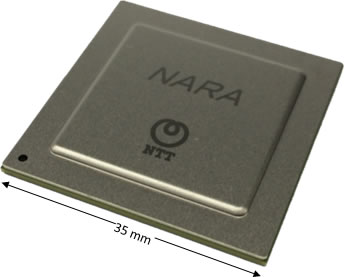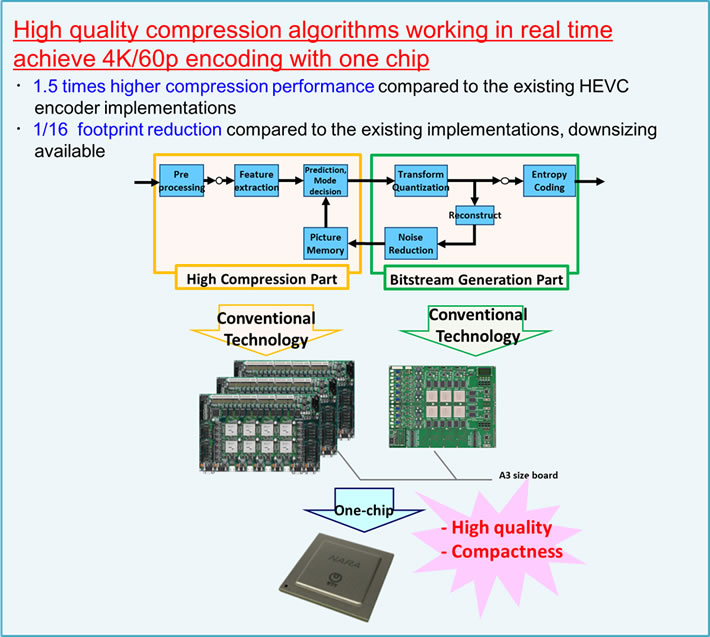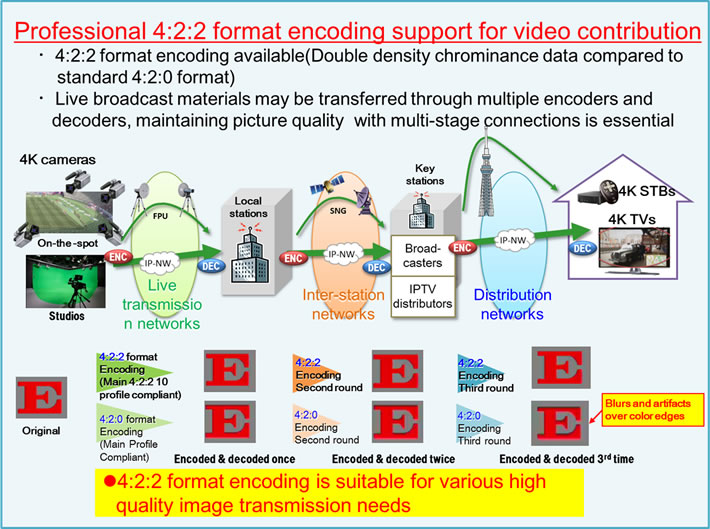NTT develops world's first professional 4K H.265/HEVC real time encoder LSI
Thursday, March 26th, 2015NTT Develops World’s First Professional 4K H.265/HEVC Real Time Encoder LSI
- Suitable for High quality 4:2:2 Video Contribution
Nippon Telegraph and Telephone (NTT) corporation (Head office, Chiyoda-ku, Tokyo, Japan; Hiroo Unoura, President and CEO) has developed a real time 4K/60p *1 ultra-high definition video encoder LSI in conformance with H.265/HEVC *2 (hereinafter called HEVC) , the latest international video coding standard.

It is the first ever LSI to comply with the Main 4:2:2 10 profile, which is capable of encoding double density chrominance data and suitable for high quality live broadcast and contribution *3 for professionals. Furthermore, one-chip processing of 4K/60p achieves not only 1/16 footprint reduction compared to the existing implementations, but also 1.5 times higher compression performance compared to the existing HEVC encoder implementations.
In the year 2020, excitement of sports is expected to be shared by many viewers throughout the world, this technology is expected to be utilized in future high resolution image fields such as ultra-high definition video services, public viewing, multi-angle TVs.
The developed technology is being exhibited at NAB 2015, the largest broadcasting technology trade show in the industry, held from April 13 in Las Vegas.
1.Background of Development
(1) Past Development
To achieve high quality video transmission and distribution services, NTT labs have developed as below,
- the world first single-chip MPEG-2*4 HDTV CODEC LSI “VASA” in summer 2002
The VASA technology has been adopted in the LSIs sustaining the terrestrial digital TV broadcasting service started in December 2003 and utilized in the essential devices of various sorts of broadcasting equipment such as MPEG-2 encoders and the digital TV relaying network.
- H.264/AVC*5 (hereinafter called H.264) CODEC LSI “SARA” in spring 2007 for professional high-quality broadcasting and distribution use
The SARA technology has also been adopted in real time transcoders that transcode MPEG-2 to H.264 for IP simulcast services of terrestrial and BS digital TV broadcasting. Both technologies are widely utilized as key components for video transmission services.
(2) Development for high quality video transmission and distribution services
Recently, ultra-high definition 4K video services with high realistic sensation have attracted attention. Enormous amount of image pixels, which is eight times larger than the standard HDTV images, is a major problem for full-scale popularization and achievement of real time encoders is craved with higher compression capability for better bandwidth efficiency and compactness for mobile and cost-efficient devices. To meet these demands, NTT labs, with technical strength cultivated by the video codec development over the years, have been involved in the research and development of HEVC-related technologies for achievement of popularization of next generation video transmission services with ultra-high definition 4K images.
2. Key Point of Development
Development of 4K HEVC real time encoder LSI for professional use (Fig. 1) :
In order to achieve high quality and high compression video services to meet professionals’ demands, NTT labs have developed a new HEVC real time encoder LSI (development code name: NARA [Next-generation Encoder Architecture for Real time HEVC Applications]) with 4K/4:2:2/60p video encoding capability.
(1) Unique high compression video encoding technology, enabling high-definition video services
New hardware algorithms for intra-frame and inter-frame prediction have been developed, adaptable to HEVC-specific variable block sizes, wide search range and high prediction efficiency is achieved. Multiplexing functions are also included in the LSI, leading to simplified configuration of encoding systems. (Fig. 2)
Fig. 2

(2) One-chip processing of 4:2:2 format images, double density chrominance data compared to 4:2:0 format (Fig. 3)
4:2:2 format images for professional use has double the chrominance data density compared to the standard 4:2:0 format for video distribution, having the advantage of avoiding color signal degradation after multiple times of encoding and decoding processes. It is therefore used when multiple times of transmission and editing is anticipated, for example, live event broadcasts. Existing technologies mainly focus on the 4:2:0 format encoding, however, NTT’s technology achieves both HEVC’s true compression performance and 4:2:2 image encoding in real time.
Fig. 3

3. Future Plans
Systems installing this LSI are hereafter under verification process for the upcoming ultra-high definition 4K transmission services, and planned to be launched after fourth quarter of year 2015 from our group businesses.
Also this LSI has an extension interface for multi-chip functions, enabling higher definition image encoding beyond 4K. In the year 2020, excitement of sports is expected to be shared by many viewers throughout the world, this technology is expected to be utilized in future high resolution image fields such as ultra-high definition video services, public viewing, multi-angle TVs.
1. 4K/4:2:2/60p images
Ultra-high definition video images with higher resolution compared to the current digital broadcast HDTV 4K video is 3840×2160 pixels resolution. 60p shows a frame frequency in the time direction, indicating that the video comprises 60 images per second in progressive scanning.
4:2:2 is an image format which has double the density of chrominance data compared to the 4:2:0 format for broadcasting and distribution, which is essential for professional high quality demands such as video contribution.
2. H.265/HEVC (High Efficiency Video Coding)
The latest video compression standard developed in April 2014 through ITU-T and ISO/IEC collaboration.
3. Contribution
Contribution refers to the transmission of video and audio materials to be edited for programs in the broadcast industry. In the case of HDTV, the bitrate used in terrestrial digital TV broadcasting is around 15 Mbps with MPEG-2 standard, but even higher rates (between 60 and 150 Mbps with MPEG-2 standard) are required for contribution used in the process of producing HDTV programs.
4. MPEG-2 (Moving Picture Experts Group-2)
MPEG is an international standard related to the compression of video images. MPEG-2 is a standard encoding method for high-quality video, including HDTV and other TV images, and is also used for DVD and digital TV broadcasting.
5. H.264/AVC (Advanced Video Coding)
A video compression standard developed in 2003 through ITU/ISO collaboration. Typical applications of the H.264 compression scheme include Blu-ray Disc and broadcasting for mobile phones (ONE-SEG).
Latest News
- Barb to start reporting TV-set viewing of YouTube channels
- SAT FILM selects multi-DRM from CryptoGuard
- Qvest and ARABSAT to launch OTT streaming platform
- ArabyAds & LG Ad Solutions partner with TVekstra in Turkey
- Freeview NZ satellite TV service to move to Koreasat 6
- Comscore expands YouTube CTV measurement internationally
